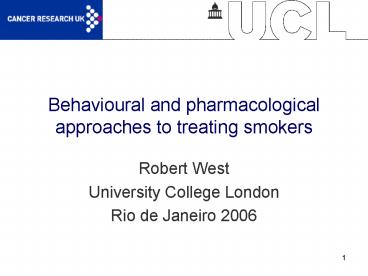Behavioural and pharmacological approaches to treating smokers - PowerPoint PPT Presentation
1 / 15
Title:
Behavioural and pharmacological approaches to treating smokers
Description:
Repeated nicotine from cigarettes interacts with other smoking ... impulses to smoke generated by smoking cues. a drive' to smoke somewhat resembling hunger ... – PowerPoint PPT presentation
Number of Views:39
Avg rating:3.0/5.0
Title: Behavioural and pharmacological approaches to treating smokers
1
Behavioural and pharmacological approaches to
treating smokers
- Robert West
- University College London
- Rio de Janeiro 2006
2
Outline
- The need for treatment
- The goals of treatment
- The effectiveness of treatment
- The future of treatment
3
The need for treatment
- Repeated nicotine from cigarettes interacts with
other smoking stimuli to generate - impulses to smoke generated by smoking cues
- a drive to smoke somewhat resembling hunger
- unpleasant physical and psychological symptoms
associated with not smoking - feelings of attraction to smoking
- positive evaluations of smoking
- These act at all levels of the motivational
system and overwhelm, undermine and subvert
self-conscious decisions to become a non-smoker
4
The role of treatment
- After some days or weeks of abstinence most of
these motivational forces tend to diminish in
frequency and intensity, but ... - the rate of decay is variable
- upsurges are common
- sometimes they persist indefinitely
- The goal of treatment
- to keep the moment-to-moment motivation to smoke
lower than the motivation to to at all times
until the motivational system recovers
5
Potential treatment targets
- Minimising frequency and intensity of motivation
to smoke - Minimise the strength of the drive to smoke
- Minimise frequency and intensity of cue-driven
impulses to smoke - Minimise adverse mood and physical symptoms
- Undermine smoker identity
- Undermine functional beliefs about smoking
- Foster adaptive mental or physical responses to
smoking triggers - Raising the action threshold
- Maximise social pressure not to smoke
- Maximise negative feelings about smoking
(disgust, worry etc.) - Foster an in-control, non-smoker identity
- Foster functional beliefs about not smoking
- Preserve mental energy needed for self-control
- Foster alternative behaviours
6
Assessing treatment outcome
- Ultimate goal is usually permanent remission
(Peter Selby) - Self-report of continuous abstinence for 6
months, biochemically verified, usually allows
reliable estimation of this (Russell Standard1) - permanent remission rate50 RS6M
- Point-prevalence estimation and estimation for
shorter time periods are less reliable - The key effect-size measure is difference in the
proportion of smokers abstinent in treatment
versus control conditions
1West et al, Addiction 2005
7
Effect of face-to-face individual support
Using only studies with 6 months continuous
abstinence and biochemical verification
8
Effect of group support
Using only studies with 12 months continuous
abstinence and biochemical verification
9
Effect of telephone counselling
Cochrane review gt6 month cessation not validated
10
Effect of tailored internet support
Not biochemically verified
11
Effect of NRT
Cochrane LI Low intensity behavioural support
HI High intensity behavioural support RTS
Reduce To Stop Combination various combinations
versus single NRT types Population NRT versus
no NRT in population samples without behavioural
support (ATTEMPT cohort study, not RCT)
12
Effect of nortriptyline, bupropion and varenicline
For bupropion and nortriptyline data from
Cochrane 6 months continuous abstinence and
biochemical verification varenicline 6 month
continuous abstinence data from JAMA 2006 blue
shading shows effect on 12 month continuous
abstinence rates of further 12w varenicline vs
placebo in smokers abstinence at 12w
13
Treatment options
- Enrol in a structured, multi-session face-to-face
or telephone-based behavioural support programme
and (unless contra-indicated) - take varenicline for 12 weeks or longer if
required, or - take nicotine patch for 2 weeks prior to quit
date then and patch plus an acute form prn for 8
weeks or longer as required, or - take bupropion for 1-2 weeks prior to quit date
and then for up to 8 weeks - Use Rx medications under clinical supervision
with additional help packages supplied - Use NRT OTC with help packages supplied
14
Costs and benefits
- Costs
- Treatments to aid cessation carry very low risk
- Behavioural treatments require some investment of
time and effort on part of smokers - Side effects of medications vary but are
generally mild - Cost per treatment episode could range from 200
for medication or behavioural support only to
800 for extended combined treatment - Benefits
- Approximately 2 to 10 percentage point
improvement in chances of permanent remission
(50 of effect on 6m abstinence) - Most successful quitters arising from the
treatment gain an average of 3 to 6 healthy life
years depending on their age and current state of
health
15
The future of treatment
- More effective use of existing treatments
- combinations
- pre-treatment
- longer term use if required
- wider access
- Better treatments
- novel medications
- cheaper medications
- more comprehensive behavioural treatments
- A realistic goal
- 25 of quit attempts that would have failed,
lasting for at least 6 months































